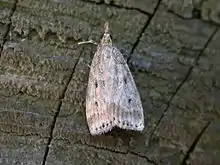| Eudonia pallida | |
|---|---|
 | |
| Scientific classification | |
| Domain: | Eukaryota |
| Kingdom: | Animalia |
| Phylum: | Arthropoda |
| Class: | Insecta |
| Order: | Lepidoptera |
| Family: | Crambidae |
| Genus: | Eudonia |
| Species: | E. pallida |
| Binomial name | |
| Eudonia pallida | |
| Synonyms | |
| |
Eudonia pallida is a species of moth of the family Crambidae. It was described by John Curtis in 1827 and is known from most of Europe. Its alternative name is the Marsh Grey.
The wingspan is about 18 mm.[2] The forewings are a very pale brownish ochreous color or just brownish, mixed with pale shades of white, and sprinkled with dark brown. The lines are white, the first nearly obsolete, the second slightly sinuate. It is the palest of all of the Scopariinae subfamily[3]
Adults are on wing in April to late September[4] in one generation per year.
The larvae feed on mosses and lichens at ground level. It has been reared from larvae found amongst the moss Calliergonella cuspidata.
References
- ↑ "Eudonia pallida (Curtis, 1827)". Fauna Europaea. Natural History Museum, Berlin. Retrieved March 4, 2018.
- ↑ "63.075 BF1336 Eudonia pallida (Curtis, 1827)". UKMoths. Retrieved March 4, 2018.
- ↑ "Recording the Wildlife of Leicestershire and Rutland | NatureSpot". www.naturespot.org.uk. Retrieved 2020-12-26.
- ↑ "Lepidoptera of Belgium". Webh01.ua.ac.be. April 26, 2004. Archived from the original on August 23, 2011. Retrieved October 11, 2011.
This article is issued from Wikipedia. The text is licensed under Creative Commons - Attribution - Sharealike. Additional terms may apply for the media files.